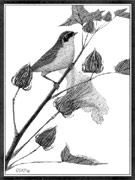|
 |
Earth Journal
by Gary Pendleton |
 The Maryland (aka Common) Yellowthroat The Maryland (aka Common) Yellowthroat
How sharply the inquisitive fellow peers at you through his mask whenever you pass the damp thicket, bordering the marshy land, where he likes best to live!
—Neltje Blanchan: Birds Every Child Should Know
Common Yellowthroat is a boring name. Sure, the bird is quite common. So why not call it the abundant yellowthroat, or as someone once said to me “Why not call it the spectacular yellowthroat?” Sure, why not?
Once upon a time this small denizen of wet places had what I, a native Marylander, think was a fine and noble name. In the years before World War II, the small warbler was known far and wide as the Maryland yellowthroat.
Why the change? It seems unfair to Free Staters. After all, Carolina has been allowed to keep both the Carolina chickadee and the Carolina wren.
A quick check of any bird book reveals a possible reason for the name change: the bird once known as the Maryland yellowthroat can be found in abundance across these United States, whereas the two above mentioned birds are considerably more restricted in their range. As Neltje Blanchan wrote about the yellowthroat back in 1907, “You see, he is something of a traveler.”
The Omaha (Nebraska) Sunday World-Herald took note of the little bird in June, 1915: “He is a little fellow, this Maryland yellowthroat, and his name designates his uniform. … Hunt him out. Make him show himself. It is worthwhile, for he is the original member of the woodland glee club.”
Perhaps if he had been celebrated as much in his namesake state, there might have been resistance to the name change. Was it the elevation of the Baltimore oriole to the office of state bird that doomed the yellowthroat to boring name oblivion?
Who remembers the name Maryland yellowthroat anymore? As far as I know, the only contemporary use of the name is by the Maryland Ornithological Society. The society’s newsletter is called The Maryland Yellowthroat.
Many years ago the bird was also known as the black-masked ground warbler because the males look like bandits, wearing a bold black mask around the eyes and the side of the head, in addition to their bright yellow throats. The females are somewhat duller over all. Males and females both have olive-colored upper parts.
The best places to find the common yellowthroat are wetlands. Once again from the Omaha Sunday World-Herald, some advice: “Just meander around some day through the thicket and weedy patches skirting a ravine or creek — there are plenty of such places near the end of your car line — and cock an expectant ear. Presently you will be surprised to hear an enthusiastic little whistle. Witchery! Witchery! Witchery!”
|
